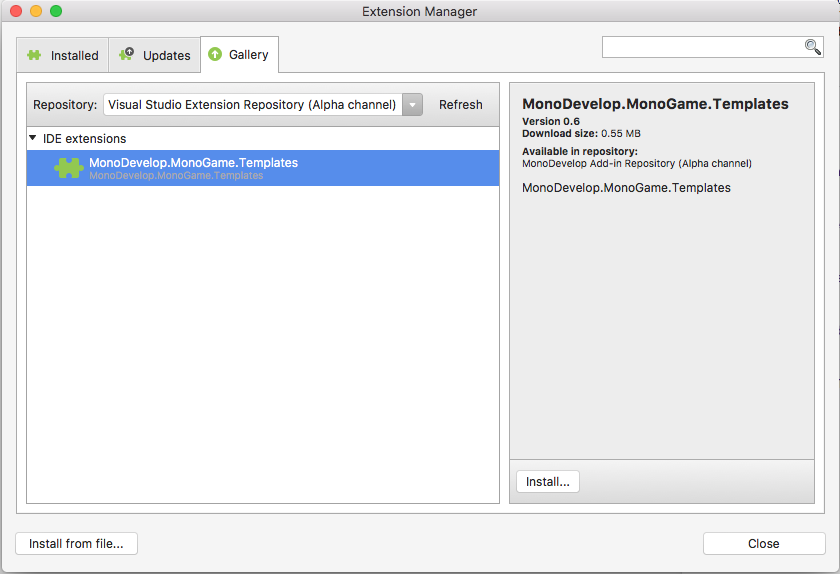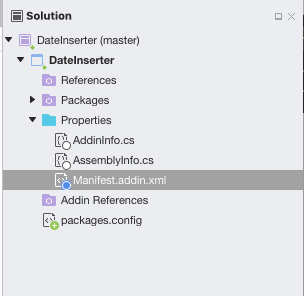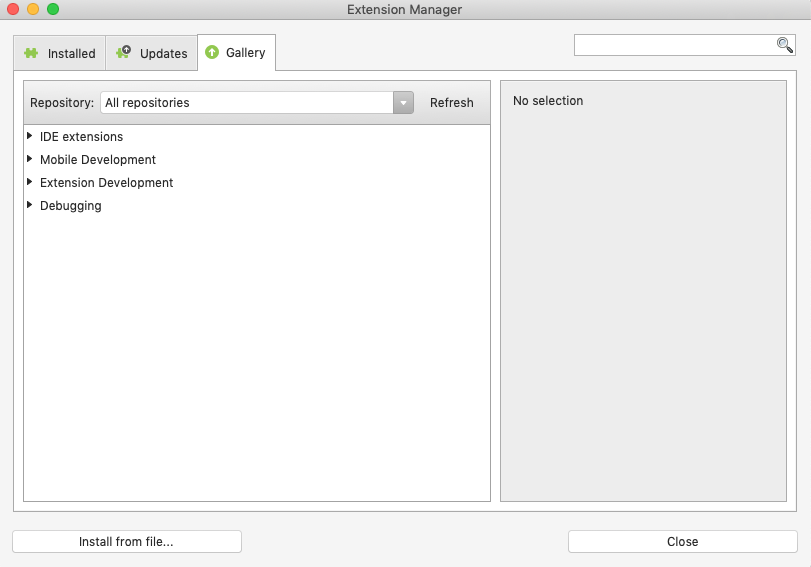Visual Studio For Mac Does Not Have Addin Manager
I also have ran into similar problem after updating the VS 2019 to 16.5.3 update and Xcode 11.4 with Mac OS Catalina 10.15.4. I can see the provisioning profile in Xcode just fine but it isn't fetching the same in Visual Studio. AddIns are no longer supported in Visual Studio, you must ask the vender for a Vspackage based extension (using the.vsix file format).
- Visual Studio For Mac Does Not Have Addin Manager Download
- Visual Studio For Mac Does Not Have Addin Manager Software
Visual Studio has not always been as user-friendly on the Mac as it is on a Windows machine. Lately, however, the stable release of VS for Mac is really starting to feel like a simple, but luxurious cousin to Visual Studio 2019. Different, but related. Installation on a Mac is quick, simple, and allows you to get into coding right away - whether you are already familiar or an Apple-only dev getting into something new like Xamarin.
Visual Studio for Mac bears a striking similarity to xCode’s solution navigation feel, but brings the power of VS intellisense and an ability to focus on your code in a much cleaner looking environment. In my opinion, this brings the best of both worlds together. But don’t take my word for it: here are five reasons to give Visual Studio for Mac another go!
1. The C# Editor in Visual Studio for Mac is Completely New
Roslyn, the .NET compiler platform, is now in the Visual Studio for Mac editor - making your intellisense as powerful as its big brother on Windows. Marrying the functionality ported over from the Roslyn compiler with the (frankly, beautiful looking) simplicity of a native-feeling Mac UI editing experience gives this girl all the feels. It has full support for third-party Nuget packages for .NET Core (utilizing .NET Standard) along with Unity, Xamarin and Cocoa apps.
I didn’t notice a big difference gating my progress of a .NET Core app. At this point, I don’t know why I would switch over to a windows VM in order to build a microservice API in .NET Core at all!
Finally, I’m loving that VS for Mac now includes “Go to implementation” as an option in the latest release. Exciting! The C# experience is pretty great now.
2. CLI Developers Can Open .NET Core Projects in Terminal
Ah, the command line. Many developers love using it for .NET Core instead of the “visual” click and drag aspect of the Visual Studio IDE. At first, the use of command line programming with ASP.NET Core was the only way you could build those apps. Over time, and especially with the release of Visual Studio 2019, the File > New Project templates for ASP.NET Core apps have been baked into the install bringing a truly visual experience to that build.
For a while, it was unclear if the same command line net new project CLI functionality would be available on Mac, but I am happy to report that it is and it works beautifully! The use of the Terminal app brings that experience to you harcore command line devs.
3. Improved Build Time for Xamarin
Remember those build and deploy coffee breaks? Well say goodbye (unless you don’t want to of course). On one of my Xamarin projects I saw a super impressive 30% faster incremental build time. That’s not an insignificant improvement.

This metric is also supported by the April 2019 press release from the VS for Mac team. I used to design my development process in such a way that I could multitask to stay efficient and productive. I’m happy to report those days are gone with much improved build speeds, making the Xamarin app building process something I can say I truly enjoy.
4. .NET Core 3 Support Available Right Out of the Gate
Does Visual Studio 2019 have .NET Core 3 support? Yes, but that’s no reason to jump over to your Windows machine! You can use all the same, wonderful new stuff on your Apple machine, too.
In fact, I’d argue that Visual Studio for Mac is an excellent place to start learning how to build apps for .NET Core 3. With fewer small windows everywhere like it’s Windows-based cousin, VS for Mac allows for a more-focused process.
5. Robust Source Control Options
This is where some “same but different” comes into play. I find that developers coming over from Swift or Objective C development enjoy the experience of source control within Visual Studio for Mac. While there IS a difference in the process for Windows users, I don’t find it particularly difficult. Visual Studio for Mac supports Git and Subversion built into the IDE, as well as TFS with a little more effort.

I have used the Github Desktop app for source control of my folders without much issue. This is also my source control workflow for VS Code, and while it is not integrated into the IDE of VS for Mac, it’s also not a bad option. For the hardcore command line peeps, you can alternatively use Git inside the CLI tool Terminal, which is native to Apple OS. There is no learning curve here at all for developers who use command line.
Who Should Use Visual Studio for Mac?
Visual Studio for Mac is a strong choice for many developers and many use cases. Here are a few that come to mind:
.NET users building Xamarin mobile apps that require IOS builds will benefit tremendously from having all their development on a single machine.
Developers working with .NET Core, who love working on a Mac, and currently use a virtual machine or Bootcamp to run Visual Studio in a windows environment will benefit from not having to switch over from the Apple operating system constantly.
Unity game developers will find VS for Mac be very intuitive option.
Visual Studio For Mac Does Not Have Addin Manager Download
The last group to come over will be .NET Framework developers who have worked with Visual Studio on Windows as their only option for .NET 4.7.2 for example. Sadly no, .NET Framework cannot run on VS for Mac. However, once you are ready to start building your apps or microservices in .NET Core - check it out!
New functionality, extensions and templates are all coming this next year to Visual Studio for Mac that make living in harmony with Apple + Microsoft a real joy.
Learn More About .NET Core, Xamarin, Apple & OAuth
If you’d like to learn more about ASP.NET, Xamarin, or Apple, we’ve also published a number of posts that might interest you:
For other great content from the Okta Dev Team, follow us on Twitter and Facebook!

This topic guides you through building a simple extension package. The extension package will create a new Command in Visual Studio for Mac's Edit menu that allows the user to insert the current date and time into an open text document.
This example uses the Add-in Maker. The Add-In Maker creates a new Project template and populates it with the required files for our custom extension package.
Begin by launching Visual Studio for Mac if it's not already open:
Install the Add-in Maker extension package using the Extension Manager. From the Visual Studio menu, choose Extensions...:
Navigate to the Gallery tab and type
Addin Makerinto the top-right search bar. Select Addin Maker from the Add-in Development category and click Install. If nothing shows up, hit Refresh and search again:Now that the Addin Maker is installed, you can start building an extension package. Start by creating a new solution.
From the New Solution dialog, choose Other > Miscellaneous > General > Xamarin Studio Addin > C# template and on the following screen name the new Solution
DateInserter:Visual Studio for Mac will populate a new Solution:
Remove the template code in
Manifest.addin.xmland replace it with the following:Now you need to set up the files that will eventually handle inserting the date and time into the text editor. Right-Click on the project node and add a new file. Select General > Empty Class and name the new file InsertDateHandler:
Let's remove the template code from
InsertDateHandler.csand replace it with the following code:We'll expand these two placeholder methods later.
Right-click on the DateInserter Project and select Add > New File. Select General > Empty Enumeration, and then name the new file DateInserterCommands:
Add the
InsertDateCommand as a new enumeration in theDateInserterCommands.csfile:At this point, you should have a working extension package. You can test it out by saving your work and running the application. The IDE will launch a new instance of Visual Studio for Mac with the new extension package installed. If you navigate to the Edit menu, you'll see that Visual Studio for Mac has a new option called Insert Date, as illustrated by the screenshot below:
Note that selecting Insert Date from the menu has no effect as the current implementation only has placeholder methods.
The framework is in place for the extension package, and it's time to write the code that powers inserting the date. First, make sure that the Insert Date Command is only enabled when the user has a text file open by replacing the
Updatemethod inInsertDateHandler.cswith the following code:Update the Command's
Runmethod to insert the date and time with the following code:Finally, let's run our extension package to test it. In the new instance of Visual Studio for Mac, select Edit > Insert Date. The current date and time is inserted at our caret, as illustrated by the screenshot below:
Visual Studio For Mac Does Not Have Addin Manager Software
See also
